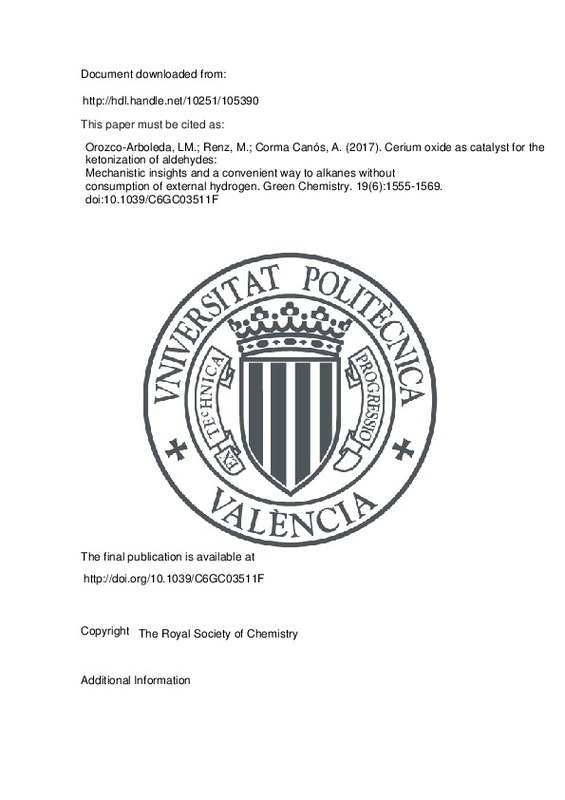JavaScript is disabled for your browser. Some features of this site may not work without it.
Buscar en RiuNet
Listar
Mi cuenta
Estadísticas
Ayuda RiuNet
Admin. UPV
Cerium oxide as catalyst for the ketonization of aldehydes: Mechanistic insights and a convenient way to alkanes without consumption of external hydrogen
Mostrar el registro sencillo del ítem
Ficheros en el ítem
| dc.contributor.author | Orozco-Arboleda, Lina Marcela
|
es_ES |
| dc.contributor.author | Renz, Michael
|
es_ES |
| dc.contributor.author | Corma Canós, Avelino
|
es_ES |
| dc.date.accessioned | 2018-07-06T07:13:45Z | |
| dc.date.available | 2018-07-06T07:13:45Z | |
| dc.date.issued | 2017 | es_ES |
| dc.identifier.issn | 1463-9262 | es_ES |
| dc.identifier.uri | http://hdl.handle.net/10251/105390 | |
| dc.description.abstract | [EN] The ketonization of aldehydes joins two molecules, with n carbon atoms each, to a ketone with 2n 1 carbon atoms. When employing cerium oxide as catalyst with nano-sized crystals (<15 nm) the ketone can be obtained in almost 80% yield. In addition, other ketones are observed so that the total ketone selectivity reached almost 90%. Water is consumed during the reaction when the aldehyde is oxidized to the corresponding carboxylic acid, which is established as a reaction intermediate, co-producing hydrogen. Consequently, water has to be co-fed in the reaction to enhance reaction rate and to improve catalyst stability with time on stream. In contrast to zirconium oxide which possesses catalytic activity for the aldol condensation liberating water, with cerium oxide water is not abundant on the surface and the reaction kinetics show that the reaction rate depends on the concentration of the water in the gas-phase, in addition to the dependence on the gasphase concentration of the aldehyde. The liberated hydrogen can be consumed in the hydrodeoxygenation of the ketone product. Doing so, when starting from heptanal, a biomass derived aldehyde, an alkane mixture was obtained with almost 90% diesel content. For the whole cascade reaction with five single steps no reagents are necessary and the only by-product is one molecule of innocuous carbon dioxide (related to two molecules of aldehyde). This shows that cerium oxide possesses a big potential to convert biomass derived aldehydes into biofuels in a very sustainable way. | es_ES |
| dc.description.sponsorship | The authors thank MINECO (CTQ2015-67591-P and Severo Ochoa program, SEV-2012-0267) and Generalitat Valenciana (PROMETEO II/2013/011 Project) for funding this work. L. M. O. is grateful to the COLCIENCIAS institute for a Francisco-Jose-de-Caldas (512/2010) doctoral fellowship. | es_ES |
| dc.language | Inglés | es_ES |
| dc.publisher | The Royal Society of Chemistry | es_ES |
| dc.relation.ispartof | Green Chemistry | es_ES |
| dc.rights | Reserva de todos los derechos | es_ES |
| dc.subject | Electron Microscopy Service of the UPV | es_ES |
| dc.subject.classification | QUIMICA INORGANICA | es_ES |
| dc.subject.classification | QUIMICA ORGANICA | es_ES |
| dc.title | Cerium oxide as catalyst for the ketonization of aldehydes: Mechanistic insights and a convenient way to alkanes without consumption of external hydrogen | es_ES |
| dc.type | Artículo | es_ES |
| dc.identifier.doi | 10.1039/C6GC03511F | es_ES |
| dc.relation.projectID | info:eu-repo/grantAgreement/MINECO//CTQ2015-67591-P/ | es_ES |
| dc.relation.projectID | info:eu-repo/grantAgreement/MINECO//SEV-2012-0267/ | es_ES |
| dc.relation.projectID | info:eu-repo/grantAgreement/GVA//PROMETEOII%2F2013%2F011/ES/Catalizadores moleculares y supramoleculares altamente selectivos, estables y energéticamente eficientes en reacciones químicas (PROMETEO)/ | es_ES |
| dc.relation.projectID | info:eu-repo/grantAgreement/COLCIENCIAS//512%2F2010/ | es_ES |
| dc.rights.accessRights | Abierto | es_ES |
| dc.contributor.affiliation | Universitat Politècnica de València. Instituto Universitario Mixto de Tecnología Química - Institut Universitari Mixt de Tecnologia Química | es_ES |
| dc.contributor.affiliation | Universitat Politècnica de València. Departamento de Química - Departament de Química | es_ES |
| dc.description.bibliographicCitation | Orozco-Arboleda, LM.; Renz, M.; Corma Canós, A. (2017). Cerium oxide as catalyst for the ketonization of aldehydes: Mechanistic insights and a convenient way to alkanes without consumption of external hydrogen. Green Chemistry. 19(6):1555-1569. https://doi.org/10.1039/C6GC03511F | es_ES |
| dc.description.accrualMethod | S | es_ES |
| dc.relation.publisherversion | http://doi.org/10.1039/C6GC03511F | es_ES |
| dc.description.upvformatpinicio | 1555 | es_ES |
| dc.description.upvformatpfin | 1569 | es_ES |
| dc.type.version | info:eu-repo/semantics/publishedVersion | es_ES |
| dc.description.volume | 19 | es_ES |
| dc.description.issue | 6 | es_ES |
| dc.relation.pasarela | S\325622 | es_ES |
| dc.contributor.funder | Generalitat Valenciana | es_ES |
| dc.contributor.funder | Departamento Administrativo de Ciencia, Tecnología e Innovación, Colombia | es_ES |
| dc.contributor.funder | Ministerio de Economía y Competitividad | es_ES |







![[Cerrado]](/themes/UPV/images/candado.png)

